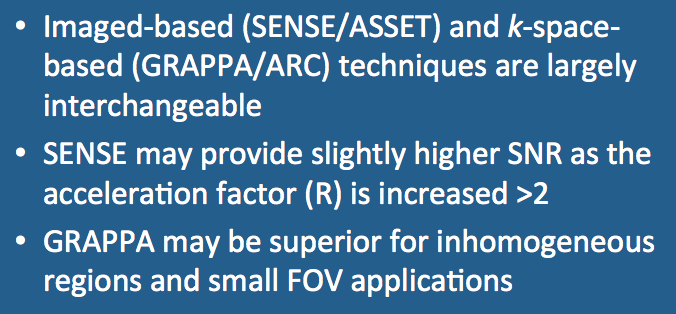To my knowledge the other major vendors do not yet offer k-space PI techniques as product.
- Total Imaging Time. GRAPPA/ARC is a somewhat longer sequence than SENSE/ASSET because it requires extra time for the self-calibration of k-space lines. This time penalty is more severe for low-resolution images where the calibration time occupies a larger percentage of total acquisition time. As the imaging matrix is increased in size, this relative disadvantage decreases.
- Signal-to-noise. SENSE/ASSET provides slightly higher SNR and better image quality as the acceleration factor is increased, but for R=2 the difference is negligible.
- Body Region. SENSE/ASSET does poorly in heterogenous body regions where accurate coil sensitivity maps may difficult to obtain (lungs); here GRAPPA/ARC may be preferred.
- Motion. SENSE/ASSET may do poorly if motion occurs between the calibration and acquisition scans, resulting in reconstruction artifacts. One obvious example is gross patient motion between sequences, even though the patient may hold perfectly still during the acquisition of each individual sequence separately. A second more subtle example applies to breath-hold liver imaging. Here, a patient may have difficulty suspending respiration to exactly the same degree between SENSE/ASSET calibration and imaging. Again, an autocalibrating technique like GRAPPA/ARC may be preferred (provided the entire sequence can be performed in the time of a single breathold). It should be noted that some newer SENSE variants (mSENSE, RAPID) use autocalibration, so this distinction disappears.
- Field-of-view (FOV). GRAPPA/ARC is more tolerant toward small FOVs. SENSE/ASSET may produce aliasing/wraparound in the phase-encode direction if the full FOV is smaller than the imaged object. Conversely, GRAPPA/ARC allows a smaller FOV to be selected without significant artifact.
- Use in Single-Shot Echo-Planar Imaging. GRAPPA/ARC holds a definite advantage over SENSE/ASSET in that susceptibility-induced field distortions are less likely to affect the reconstruction process.
Advanced Discussion (show/hide)»
Some more advanced follow-up questions and explanations appear below:
Why is GRAPPA better than SENSE for highly inhomogeneous regions like the lung and abdomen? The answer is that SENSE requires the generation of accurate sensitivity maps from each coil, which may be difficult to obtain. In GRAPPA, estimation of missing k-space lines is more of a global process involving data from all three coils simultaneously plus the autocalibration region; it is not as affected by local inhomogeneities. Acquiring extra lines at the center of k-space also improves signal-to-noise and estimation accuracy.
Why is GRAPPA better for single-shot echo-planar imaging (EPI)? Here, coil sensitivity maps are the problem. EPI methods suffer image distortions originating from differences in local resonant frequencies due to susceptibility effects. With SENSE image distortions due to susceptibility effects and coil sensitivity maps may be different. For reasons described above, in GRAPPA these image distortions have relatively little effect on the estimation of missing k-space lines.
Why is GRAPPA more tolerant to small FOVs? For some PI applications (like cardiac MRI), relatively small FOVs are needed to view the anatomy of interest. By reducing the full FOV, gross aliasing occurs beyond that induced by the PI process itself. In SENSE/ASSET this aliasing cannot be corrected by the usual PI unfolding algorithms. A "SENSE Ghost" artifact in the center for the image is commonly observed. Conversely, GRAPPA/ARC is able to generate partially aliased full FOV images without any modifications to its reconstruction algorithm. Recall that a small FOV corresponds to a greater than usual spacing between k-space lines. Simply increasing line spacing does not significantly affect the GRAPPA/ARC estimation of missing lines. Hence GRAPPA/ARC methods are preferred for small FOV applications.
Blaimer M, Breuer F, Mueller M, Heidemann RM, Griswold MA, Jakob PM. SMASH, SENSE, PILS, GRAPPA. How to choose the optimal method. Top Magn Reson Imaging 2004;15:223-236 [review].
Brau A. New parallel imaging method enhances imaging speed and accuracy. GE Signa Pulse, 2007; 36-38. (Promotional piece describing GE's ARC method).
Griswold MA, Jakob PM, Heidemann RM, et al. Generalized autocalibrating partially parallel acquisitions (GRAPPA). Magn Reson Med 2002; 47:1202-1210
Pruessmann KP, Weiger M, Scheidegger MB, Boesiger P. SENSE: Sensitivity encoding for fast MRI. Magn Reson Med 1999; 42:952-962.
What is parallel imaging? How does this differ from "regular" imaging?
How does GRAPPA/ARC work?
